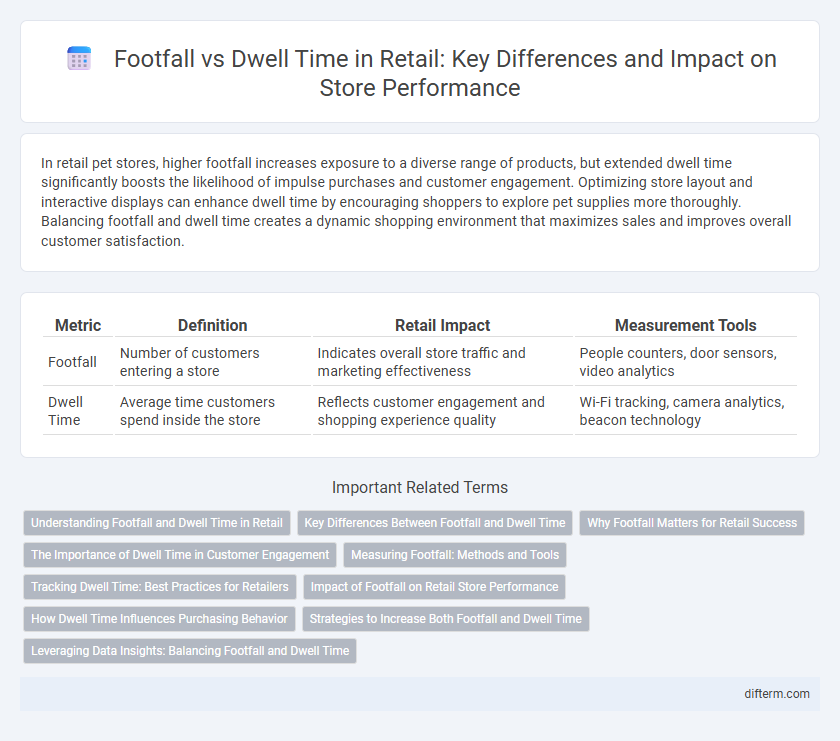In retail pet stores, higher footfall increases exposure to a diverse range of products, but extended dwell time significantly boosts the likelihood of impulse purchases and customer engagement. Optimizing store layout and interactive displays can enhance dwell time by encouraging shoppers to explore pet supplies more thoroughly. Balancing footfall and dwell time creates a dynamic shopping environment that maximizes sales and improves overall customer satisfaction.
Table of Comparison
| Metric | Definition | Retail Impact | Measurement Tools |
|---|---|---|---|
| Footfall | Number of customers entering a store | Indicates overall store traffic and marketing effectiveness | People counters, door sensors, video analytics |
| Dwell Time | Average time customers spend inside the store | Reflects customer engagement and shopping experience quality | Wi-Fi tracking, camera analytics, beacon technology |
Understanding Footfall and Dwell Time in Retail
Footfall measures the number of customers entering a retail store, providing key insights into store traffic and overall visit volume. Dwell time tracks how long shoppers stay within the retail space, indicating customer engagement and the effectiveness of store layout. Analyzing footfall alongside dwell time helps retailers optimize merchandising strategies and staff deployment to boost sales conversion rates.
Key Differences Between Footfall and Dwell Time
Footfall measures the number of visitors entering a retail space, providing quantitative data on store traffic, while dwell time captures the duration visitors spend inside, reflecting engagement and interest levels. Footfall trends help assess overall store popularity and peak hours, whereas dwell time insights reveal shopper behavior and the effectiveness of store layout or merchandising. Understanding the key differences between footfall and dwell time enables retailers to optimize staffing, marketing strategies, and store design to boost sales and customer experience.
Why Footfall Matters for Retail Success
Footfall, the number of customers entering a store, directly influences retail revenue by increasing potential sales opportunities. High footfall enhances brand exposure and allows retailers to gather valuable data on customer behavior and preferences. Prioritizing strategies to boost footfall supports sustained business growth and competitive advantage in the retail market.
The Importance of Dwell Time in Customer Engagement
Dwell time significantly impacts customer engagement by indicating how long shoppers remain in-store, directly correlating with their likelihood to explore products and make purchases. Increased dwell time enhances the chances of impulse buying and fosters stronger brand connections, crucial metrics for retail success. Retailers leveraging footfall data alongside dwell time analysis can optimize store layouts and personalize experiences, boosting overall sales performance.
Measuring Footfall: Methods and Tools
Measuring footfall in retail involves using advanced tools such as infrared sensors, video analytics, and Wi-Fi tracking to capture accurate customer entry counts and movement patterns. These methods provide granular data on visitor frequency, peak hours, and in-store traffic flow, enabling retailers to optimize store layout and staff allocation. Integrating footfall measurement tools with point-of-sale systems enhances the correlation between traffic and sales performance, driving data-driven merchandising and marketing strategies.
Tracking Dwell Time: Best Practices for Retailers
Tracking dwell time in retail requires precise measurement tools such as video analytics and heat mapping to accurately capture how long customers spend in specific areas. Optimizing store layout and product placement based on dwell time data enhances customer engagement and increases conversion rates. Regular analysis of dwell time combined with footfall metrics enables retailers to refine marketing strategies and improve overall store performance.
Impact of Footfall on Retail Store Performance
High footfall directly boosts retail store performance by increasing potential customer interactions, which can lead to higher sales volume and revenue. Enhanced foot traffic also improves brand visibility and market presence, attracting diverse consumer segments and driving repeat visits. Retailers leveraging footfall analytics can optimize staffing, merchandising, and promotional strategies to maximize conversion rates and overall sales efficiency.
How Dwell Time Influences Purchasing Behavior
Dwell time in retail stores significantly impacts purchasing behavior by increasing customer engagement with products, leading to higher conversion rates. Longer dwell time allows shoppers to explore merchandise more thoroughly, boosting the likelihood of impulse purchases and enhancing overall sales. Retailers optimize store layout and in-store promotions to extend dwell time, ultimately driving revenue growth.
Strategies to Increase Both Footfall and Dwell Time
Effective retail strategies to increase footfall and dwell time include enhancing store layout to create inviting pathways and comfortable zones that encourage customers to explore and linger. Implementing interactive displays and personalized services boosts customer engagement, thereby extending the duration of visits. Leveraging data analytics to tailor promotions and optimizing in-store experiences through sensory elements like lighting and music also contribute significantly to attracting more visitors and increasing the time they spend in-store.
Leveraging Data Insights: Balancing Footfall and Dwell Time
Analyzing footfall and dwell time data offers retailers critical insights to optimize store layouts and staff allocation, driving sales by enhancing the customer experience. High footfall with low dwell time may indicate quick visits lacking engagement, while longer dwell times suggest deeper customer interest and potential for upselling. Leveraging these metrics through advanced analytics enables personalized marketing strategies and inventory adjustments, maximizing revenue and operational efficiency.
Footfall vs Dwell time Infographic

 difterm.com
difterm.com